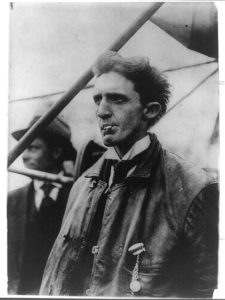Born in New Britain, Charles K. Hamilton became interested in flying at an early age. In 1903, at age 18, he became active in hotair ballooning and parachute jumping at circuses and fairs. Three years later he began piloting dirigibles.
Early Aviator
In 1909, after the problem of heavier-than-air flight was solved, Hamilton learned to fly airplanes under Glenn H. Curtiss. Hamilton joined Curtiss’s exhibition team and quickly acquired fame. Exhibitions, races, long-distance flights and other forms of aerial competition became regular attractions across the United States and Europe.
Record-setting Flights
In 1910, Hamilton won a prize of $10,000 for being the first to fly from New York to Philadelphia and back. That same year he made his first public flight in Connecticut. This was the first reliably documented heavier-than-air flight in the state. Hamilton flew over New Britain as part of Aviation Day in Walnut Hill Park (July 2, 1910). In Nashville (in 1910), he made the first night flight in America, remaining aloft 25 minutes before developing engine trouble.
Barnstormer
As exhibition flying became profitable, aerobatic displays by daredevil pilots began to supplement races and other competitive events. In 1911, Hamilton joined Moissant’s International Aviators, a group of flyers who toured the United States performing daredevil exhibitions, hawking barnstorming flights, and reportedly earning $100,000 a year.
Hamilton became known for his dangerous dives, the “Hamilton Glide,” spectacular crashes, extensive reconstructive surgeries, and ever-present cigarette. The Hamilton Glide was a stunt in which he turned off the engine of his plane and glided the craft down to safety. He came about this maneuver by accident, when his plane’s crankshaft broke during a performance and he glided his plane to the ground. He survived 60 crashes.
Although Hamilton’s aviation career was undoubtedly spectacular, sadly, it was cut short when he died at age 28 from a lung hemorrhage after a long bout with tuberculosis. Legend has it, in a fitting tribute at his funeral, a group of aviators flew over his grave site and dropped flowers from their planes.
To learn more about Cedar Hill’s remarkable aviators, check out our Barnstormers & Aviators video.
Location:
Section 4, Lot 43
References:
Early Aviators. Accessed at http://earlyaviators.com/ehamil01.htm
LeShane, Albert A. Hardware City Fliers: Early Aviation in New Britain. Portland, CT: Connecticut Aeronautical Historical Association, 1986.
Photo Credit:
Charles K. Hamilton, Library of Congress #LC-USZ62-35560;

